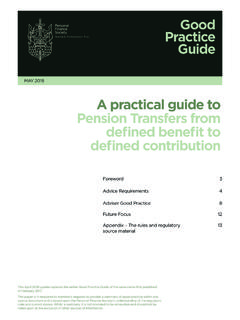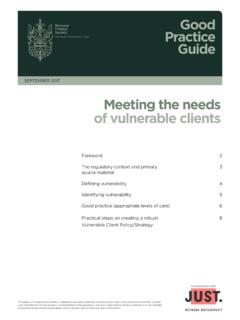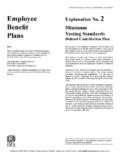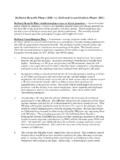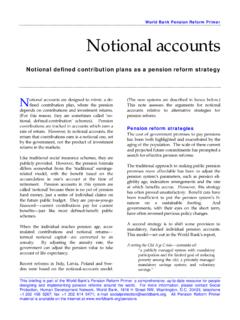Transcription of Good Practice Guide - The Personal Finance Society
1 Pension transfers from defined benefit to defined contributionFEBRUARY 2017 This paper is in response to member s requests to provide a summary of good Practice within one source document and is based upon the Personal Finance Society s understanding of the regulators rules and current stance. Whilst a summary, it is not intended to be inclusive and should not be relied upon at the exclusion of other sources of Practice GuideForeword 2 The rules and regulatory source material 3 Advice requirements 4 Adviser good Practice 7 good Practice guideGood Practice Guide /February 20172 good Practice GuideIn most cases transferring pension benefits is irreversible and in some cases the merits or otherwise of the transfer may only become apparent years into the future. So it is particularly important that firms advising on pension transfers ensure that their clients understand fully the implications of a proposed transfer before deciding whether or not to the insistent client debate has focused attention on a lack of appetite from many financial advisers to carry out pension transfers from defined benefit to defined contribution schemes, specialist pension transfer firms are seeing record levels of enquiries, fuelled by the consumers desire to benefit from pension freedoms alongside historically attractive transfer values given continuing low interest rates and gilt has not escaped the attention of the Financial Conduct Authority, who on 24/1/2017 reiterated their expectations on advice on pension transfer, including transfer from a defined benefit (DB) scheme or other scheme with safeguarded benefits.
2 Whilst transferring a DB Pension to a DC Pension can offer a more flexible retirement income, the possibility of extra tax free cash and an easier inheritance (given transferred funds can be passed on to heirs), retaining a DB Pension can also provide certainty, a risk-free income and degrees of inflation protection. The following sections of this paper are in response to member s requests for further commentary and clarification around good Practice , leaving it ultimately to firms to ensure they comply with both the detail and the spirit of the regulators rules. No-one should be in any doubt that the regulator will continue to scrutinise DB transfers as it considers a future thematic review on this RichardsChief Executive Officer, the Personal Finance SocietyGood Practice guideGood Practice Guide /February 20173 The rules and regulatory source materialDate (last updated)Nature of FCA communicationContentLink24/1/2017 FirmHighlights FCA requirements when providing advice on pension transfers, including advice in particular FCA expects to consult during Q1 2017 on updating the pension transfer redress the FCA considers to be good and poor Practice when advising insistent alert - Advising on pension transfers with a view to investing pension monies into unregulated products through a consumer guidance on what to consider if thinking about transferring a defined benefit pension, or if you moving or combining a defined contribution in understanding the FCA s position on insistent clients, following the pension reforms in transfers, conversions, and opt- 2015 Policy Statement PS 15/12 Proposed changes to FCA pension transfer rules , feedback on CP15/7 and final Practice guideGood Practice Guide /February 20174 Advice requirements(This section covers the basic requirements from governments and regulator)
3 Section 48 of the Pension Schemes Act 2015 This requires that trustees or scheme managers check that regulated financial advice has been taken before allowing a transfer to proceed, where the proposed transfer involves a DB pension, or other safeguarded benefits, worth more than 30, s guidance for providing advice on a DB transferThe FCA s guidance for providing advice on a DB transfer continues to be that firms should start by assuming that the transfer is not suitable. A recommendation to transfer should only be made if this can be clearly shown to be demonstrably suitable and in the client s best the FCA says (COBS ): When advising a retail whether to a firm should start by assuming that a transfer, conversion or opt-out will not be suitable. A firm should only then consider a transfer, conversion or opt-out if it can clearly demonstrate, on contemporary evidence, that the transfer, conversion or opt-out if it is in the client s best interests. (COBS ) When a firm advises a retail client on a pension transfer, it should consider the client s attitude to risk including, where relevant, in relation to the rate of investment growth that would have to be achieved to replicate the benefits being given up When giving a Personal recommendation about a pension transfer, a firm should clearly inform the retail client the consequent transfer of risk from the defined benefits pension scheme.
4 To the retail client Including the extent to which benefits may fall short of replicating those in the defined benefits pension In considering whether to make a Personal recommendation, a firm should not regard a rate of return which may replicate the benefits being given up from the defined benefits pension scheme or other scheme with safeguarded benefits as sufficient in this may feel a little outdated in the post-pension freedoms market and at a time when many DB schemes are in deficit, until such time as a review of this assumption takes place, it should remain the starting point for any permission and responsibility for adviceOnly firms with the FCA permission to advise on pension transfers may do so. It is not acceptable for a firm without the permission to outsource the transfer analysis to a pension transfer specialist or to a firm with the permission, and claim to be advising on the pension firm without the permission may refer a client needing pension transfer advice to a firm with the permission.
5 However, it is not acceptable for that second firm to claim to be advising on the pension transfer without taking into account the assets in which the client s funds will be invested as well as the specific receiving scheme. Where both firms may be responsible for different elements of advice given to the client, firms are expected to liaise for a firm with the permission, FCA rules permit an individual who is not a pension transfer specialist to advise on pension transfers. However, the firm must ensure that the advice is checked by a pension transfer specialist. The firm advising on the transfer remains responsible for the advice, including the advice checked by the pension transfer specialist, even where the pension transfer specialist is not employed by the Practice guideGood Practice Guide /February 20175 FCA position on Insistent Client An insistent client is a client who wishes to take a different course of action from the one you recommend and wants you to facilitate the transaction against your advice.
6 Where clients are required to take advice (for example in relation to DB pensions and other safeguarded benefits) then some may decide to disregard that FCA highlights 3 key steps to take when advising an insistent client:1. You must provide advice that is suitable for the individual client and this advice must be clear to the client. Advice on pension transfers should follow the normal advice process for pension transfers2. You should be clear with the client what the risks of the alternative course of action are3. You should be clear with the client that their actions are against your based solely on critical yieldThe FCA s supervisory work has revealed that some firms have been recommending pension transfers based solely on whether or not the critical yield is below a certain rate set by the firm for assessing transfers generally. This does not meet the regulators FCA expects a firm to consider the likely expected returns of the assets in which the client s funds will be invested relative to the critical Personal Finance Society has urged the government and regulator to introduce new rules which safeguard advisers against future misselling claims from insistent clients.
7 Currently, it remains our view that those advisers that facilitate a transfer against their own advice, will be party to arranging an unsuitable solution and as such, might be deemed liable in the event of a future complaint in the absence of any guarantees or input from the regulator on how the Financial Ombudsman Service will interpret such Practice guideGood Practice Guide /February 20176 FCA expectations re consideration of assetsThe FCA expect a firm advising on a pension transfer from a defined benefit (DB) scheme or other scheme with safeguarded benefits to consider the assets in which the client s funds will be invested as well as the specific receiving scheme. It is the responsibility of the firm advising on the transfer to take into account the characteristics of these rules set out what a firm must do in preparing and providing a transfer analysis. In particular, their rules (COBS (1)) require a comparison between the benefits likely (on reasonable assumptions) to be paid under a DB scheme or other scheme with safeguarded benefits and the benefits afforded by a Personal pension scheme, stakeholder scheme or other pension scheme with flexible comparison should explain the rates of return that would have to be achieved to replicate the benefits being given up and should be illustrated on rates of return which take into account the likely expected returns of the assets in which the client s funds will be invested.
8 Unless the advice has taken into account the likely expected returns of the assets, as well as the associated risks and all costs and charges that will be borne by the client, it is unlikely that the advice will meet FCA expectations (see guidance at COBS and ).What this means is that a firm advising on a pension transfer should not undertake a comparison using generic assumptions for hypothetical receiving schemes. The firm must take into account the likely expected returns of the assets in which the client s funds will be invested as well as the specific receiving recommendationsIn making Personal recommendations, the firm will need to comply with FCA requirements regarding the suitability of the advice provided. The firm should make clear the loss of any safeguarded benefits and the consequent transfer of risk to the client, including: investment risk longevity risk, and the risk that products may not be available or cost effective to meet the client s needs in guidance on the suitability of pension transfers (COBS (G)) clearly states that when a firm advises a retail client on a pension transfer it should consider the client s attitude to risk including, where relevant, in relation to the rate of investment growth that would have to be achieved to replicate the benefits being given Practice guideGood Practice Guide /February 20177 Adviser good Practice (This section looks at suggested good Practice in respect of key advice considerations)1.
9 Understand the DB Scheme. Advisers should be familiar with and seek to fully understand the DB Schemes from which a transfer is being made, their benefit structures and variances. In extreme cases where a scheme is in danger of entering the Pension Protection Fund is the protected amount under the PPF much lower than the amount of the transfer value?2. Fully assess both harder and softer facts. Some reasons why a member might wish to transfer relate to lifestyle factors rather than whether the DB or DC alternative will pay a comparable or higher income. As such, analysis of softer factors such as risk appetite, health, marital status and dependants need to be considered alongside harder facts such as income levels, TVAS analysis, cash flow modelling Consider the wider tax issues of the client. A common reason to transfer benefits from a DB to DC scheme is to defer income, often to avoid paying unnecessary income tax. However, a DB transfer can result in taxation issues for the client, particularly where high transfer values are involved.
10 For example, the assessment against the lifetime allowance is often more favourable for a DB scheme pension than for crystallised or uncrystallised Personal pension. In addition, any potential impact on IHT will need to be taken into account, not just in terms of where PCLS is taken or is planned to be taken, but also where an individual dies within two years of making a transfer. In such circumstances, the executors of the persons Will are required to report this to HMRC and where the person was in normal health, HMRC deems there no loss to the estate. However, if the person knew they were seriously ill when the transfer took place (for example, expecting to live for less than two years) then an IHT charge can arise. So if death benefits are a key driver due to the ill health of a member, being aware of the IHT position is critical (albeit that transferring could still be the best outcome even after an IHT charge).4. Ensure DB transfer matches client s attitude to risk A transfer from a DB scheme to a DC pension usually involves a higher amount of risk for the client.
